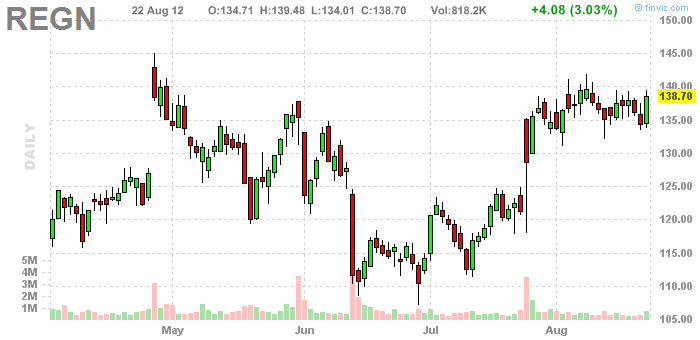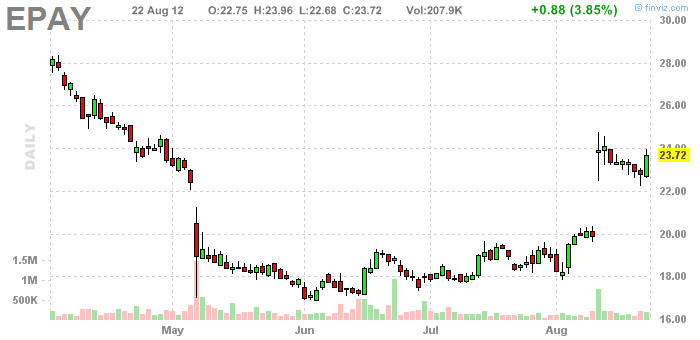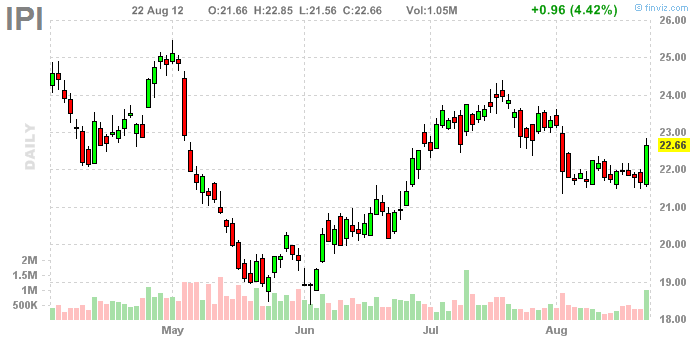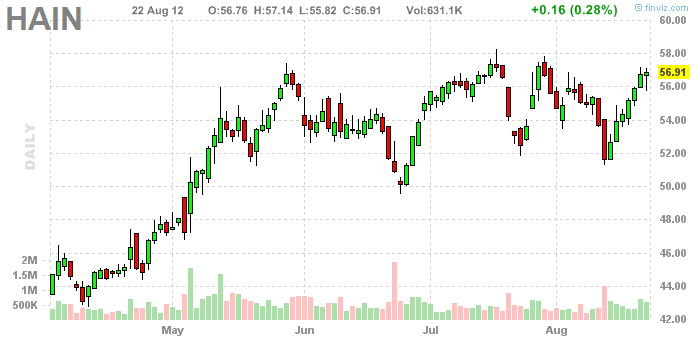
martes, 29 de enero de 2013
sábado, 26 de enero de 2013
Earn PPLT had a big eversal
Earn 

After spending many days going sideways, the indexes had a breakout to upside. The Nasdaq 100 continues to lead. Small caps had 2 nice up days.
One of the better looking ETF setup was on PPLT, which is a Platinum ETF. It had a big reversal after being in downtrend for sometime.
jueves, 24 de enero de 2013
miércoles, 16 de enero de 2013
Earn Breadth is improving
Earn 

Breadth has seen steady improvement in last 6 session.
The underlying setups are improving . At this stage a sideways move may help in consolidating the gains.
The markets have also managed to get out of a channel.
martes, 8 de enero de 2013
Signals Few good setups
Signals 






Swing Play

pullback play
Swing Play

145 possible target
Swing Play

24.5 possible target.
Swing Play

24 possible target
Stock To watch

Earnings last night.
sábado, 5 de enero de 2013
Signals Mexico says G20 to look at smoothing capital flows
Signals Mexico says G20 to look at smoothing capital flows Mexican Finance Minister Jose Antonio Meade speaks during an interview with Reuters in Mexico City February 14, 2012. REUTERS/Henry RomeroView Photo Mexican Finance Minister Jose Antonio Meade speaks during an interview with Reuters in Mexico City February 14, 2012. REUTERS/Henry Romero MONTEVIDEO (Reuters) - Mexico will include possible steps to blunt the impact of sharp capital flows on the Group of 20's policy agenda after discussions with Latin American neighbors, Finance Minister Jose Antonio Meade said on Sunday. Mexico, which holds the G20's rotating presidency this year, hosted a seminar about G20 priorities on the sidelines of meetings of Inter-American Development Bank. The bloc's only Latin American members are Brazil, Mexico and Argentina. Meade said via his Twitter account that suggestions from the region would help to enrich the work of the G20, including a push to ease the impact of capital inflows and outflows and tools to administer flows better. One suggestion Mexico would take on board was to 'develop a better capacity to absorb financial flows in domestic financial systems,' he said. Many delegates at the IADB meeting have expressed concern about a recent move toward protectionism, particularly by Brazil, which last week pushed Mexico to curb auto exports over the next three years to boost its industrial sector, hit by an appreciating currency. Brazil blames loose monetary policy in developed economies for the foreign cash flows that have pushed up the real and unleashed a flood of cheap imports, hurting the competitiveness of Brazilian industries. Officials present at the Montevideo meeting said Uruguay, Paraguay and other countries had pushed for Mexico to make sure the G20 addressed currencies and trade barriers. 'Mexico was asked to raise issues of protectionism, exchange rates and capital flows,' Paraguay Economy Minister Dionisio Borda said. Meade told Reuters the G20 remained committed to combating protectionism and there was no intention to change this. 'In every G20 meeting what we have done is reconfirm the promise to combat protectionism, recognizing that this is a measure which does not contribute to global growth,' he said. In the G20 leaders' November communiqué, the group said multilateral trade was important as a way to avoid protectionism and called for more exchange rate flexibility. Protectionism and capital flows were not specifically mentioned in the communiqué following the G20 finance ministers' meeting in Mexico City in March, but Mexico has said one of its G20 priorities is economic stabilization. (Reporting by Krista Hughes and Guido Nejamkis; Editing by Maureen Bavdek)
jueves, 3 de enero de 2013
Signals Is the Euro Decoupling From U.S. Stocks?
Signals Is the Euro Decoupling From U.S. Stocks? Companies: EUR/USD S&P 500 NASDAQ Composite RELATED QUOTES Symbol Price Change EURUSD=X 1.2832 +0.0123 ^GSPC 1,291.87 -0.61 ^IXIC 2,715.73 +4.97 ^DJI 12,432.35 -17.10 FXE 127.78 +1.22 For much of the last 15 years the S&P 500 and euro (the EU currency) have been moving in the same direction. Since its May 4, 2011 high (the euro topped two days after U.S. stocks) the euro has tumbled 15%. Worse yet, the euro has been falling over the past few weeks even though the S&P has remained stable. Will the S&P soon catch up with the euro, or is the euro about to decouple its positive correlation with U.S. equities? Euro Problems Euro problems are the reason for the bad euro season. U.S. stocks got to enjoy the Santa Claus Rally while the euro was stuck with debt concerns that include: - Eurozone governments need to refinance more than $1.3 trillion in debt in 2012. - Yields on Italian bonds crept up about 7% again (above 7% yields send Greece into a tailspin). - Standard & Poor's is expected to strip France of its AAA rating as early as this month. - Spain's banks need to raise an extra $65 billion to cover bad property loans. - In February, Italy needs to sell more debt than could be covered even if investors used all the proceeds of maturing securities to buy the bonds. Euro Hope Things are so bad for the euro (EURUSD=X), they are good. So it seems at least. The chart below shows the euro holdings of the 'smart' and 'dumb' money published by the Commodity Futures Trading Commission. The first gray graph shows total non-reportable short positions. Non-reportable are small traders considered the dumb money. The second gray graph shows reportable commercial short positions. Commercial traders are the 'pros' that actually provide a commodity or instrument and are considered the smart money. The data shows that non-reportable short positions are pretty high right now (data as of Tuesday) while commercial traders have closed nearly all their short positions. Based on COT sentiment data, the euro should be close to a bottom, at least a temporary one. Cause for U.S. Stock Rally? But wouldn't a rising euro translate into rising U.S. stocks? Under normal circumstances, yes it would. A look at the chart below shows that a rising euro usually correlates with a rising S&P 500. The red boxes highlight periods of falling euro and rising S&P (such as lately). The green box identifies a period of time when a rising euro (NYSEArca: FXE - News) coincided with falling (even rapidly falling) U.S. stock prices. This happened from October 2007 - July 2008. Putting Odds in Your Favor It's no secret that I declared the rally from the October lows to be a counter trend rally. Back on October 2, I stated via the ETF Profit Strategy updated that: 'I don't think October will 'kill' this bear market, but it should spur a powerful counter trend rally. Towards the end of this rally Wall Street may applaud the Fed for launching Operation Twist and QE3 may be considered unnecessary. This kind of positive environment would be fertile soil for the next bear market leg (Q1 or Q2 2012). From a technical point of view this counter trend rally should end somewhere around 1,275 - 1,300.' To identify high-probability trade setups, I like to see technicals, sentiment, and seasonality point in the same direction, such as they did in early October. From a seasonal perspective, October has the reputation of a 'bear market killer.' Sentiment polls showed the most bearish readings in over a year and the VIX (Chicago Options: ^VIX) was close to the 2010 high. At the same time, the S&P had reached rock bottom support. Based on the weight of evidence, the October 2 ETF Profit Strategy update also predicted that: 'The ideal market bottom would see the S&P dip below 1,088 intraday followed by a strong recovery and a close above 1,088.' On October 4, the S&P briefly dipped below 1,088 and closed the day at 1,124. A massive counter trend rally was born that day. The Next Setup? Seasonality is once again turning bearish (or at the very least less bullish). Since 2002, the S&P reached a January top followed by a drop greater than 8% five (out of ten) times. 51.1% of all investment advisors and newsletter-writing colleagues (polled by II) are bullish on stocks (the highest reading since May 3) while only 17% of individual investors (polled by AAII) are bearish, the second lowest reading in six years. From a technical point of view, the S&P (SNP: ^GSPC - News) is about to reach a daunting resistance cluster comprised of Fibonacci levels and various long and short-term trend lines. The Dow (DJI: ^DJI - News) is about to encounter two trend lines that go back nearly five years. The resistance clusters for the Nasdaq (Nasdaq: ^IXIC - News), Russell 2000 (NYSEArca: IJR - News), and financials (NYSEArca: XLF - News) are not as glaring but they're there. The only thing that doesn't quite fit into the equation is the euro's sentiment data illustrated above. Nevertheless, the weight of evidence suggests that a turnaround for stocks, and possibly another significant market top, may be just around the corner. The high probability strategy is to short U.S. stocks as soon as the resistance cluster is reached or support is broken. The ETF Profit Strategy Newsletter identifies the target of this rally along with a short, mid and long-term outlook and the corresponding ETF profit strategies.
martes, 1 de enero de 2013
Forex Top 5 Global Mutual Funds
Forex Top 5 Global Mutual Funds Companies: Thornburg Global Opportunities A Artio Global Equity A Oppenheimer Global Opportunities A RELATED QUOTES Symbol Price Change THOAX 14.34 0.00 BJGQX 33.60 -0.06 OPGIX 27.86 +0.50 MWOFX 24.77 -0.12 ICDAX 11.66 +0.06 The fortunes of U.S. equity markets continue to be a key determinant of the health of the global economy. However, their dominance has receded significantly over the years and a world of exciting opportunities has emerged in global markets. Moreover, research has shown that a portfolio with a combination of domestic and foreign securities produces greater returns over the long term. Global funds allow investors to hold an optimum combination of international and domestic investments without incurring the costs of holding such securities individually. Below we will share with you 5 top rated global mutual funds. Each has earned a Zacks #1 Rank (Strong Buy) as we expect these mutual funds to outperform their peers in the future. To view the Zacks Rank and past performance of all global funds, then click here. Thornburg Global Opportunities A (NASDAQ:THOAX - News) seeks capital growth over the long term. The fund invests in a wide range of equity securities worldwide. This includes common and preferred stocks, real estate investment trusts and other equity trusts. The global mutual fund has a five year annualized return of 2.1%. The global mutual fund has a minimum initial investment of $5,000 and an expense ratio of 1.48% compared to a category average of 1.44%. Artio Global Equity A (NASDAQ:BJGQX - News) invests the majority of its assets in companies worldwide. Under normal circumstances, not less than 40% of its assets are invested in at least three foreign countries. A maximum of 35% of its assets may be utilized to purchase emerging market securities. The global mutual fund has a three year annualized return of 10.04%. Rudolph-Riad Younes is the fund manager and he has managed this global mutual fund since 2004. Oppenheimer Global Opportunities A (NASDAQ:OPGIX - News) seeks capital growth as well as current income. The fund invests in a wide range of equity securities worldwide. The fund focuses on acquiring stocks, but may also purchase debt securities. The global mutual fund has a ten year annualized return of 8.53%. As of November 2011, this global mutual fund held 100 issues, with 5.24% of its total assets invested in Advanced Micro Devices Inc. MFS Global Growth A (NASDAQ:MWOFX - News) invests in both domestic and foreign securities, as well as emerging market securities. The fund may invest a substantial part of its assets in a relatively small number of countries. The global mutual fund returned 2.36% in the last one year period. The global mutual fund has a minimum initial investment of $1,000 and an expense ratio of 1.53% compared to a category average of 1.44%. Ivy Cundill Global Value A (ICDAX) seeks capital growth. The fund purchases both domestic and foreign equity securities. Not more than 20% of its assets are invested in debt securities issued by companies which have filed for bankruptcy or are likely to do so shortly. The global mutual fund has a three year annualized return of 8.15%. The fund manager is James Thompson and he has managed this global mutual fund since 2009. To view the Zacks Rank and past performance of all global mutual funds, then click here. About Zacks Mutual Fund Rank By applying the Zacks Rank to mutual funds, investors can find funds that not only outpaced the market in the past but are also expected to outperform going forward. Learn more about the Zacks Mutual Fund Rank at http://www.zacks.com/funds.
Earn FRCN - Stock Moves Over 100%
Earn

I made FRCN a chart to watch and posted about it earlier stating I liked it for a bottom trade: http://pennystockgurus.blogspot.com/2012/06/frcn-bottom-trade.html
BEFORE:
AFTER
Oil BBDA Hits New Highs - Continues its 2 Month Long Rally
Oil
I don't like to revisit a stock on a daily basis, but BBDA continues to give me a reason to write about them. The stock sat at $.0003 a little over two months ago (its 52 week low) and hit a high today of .0172 today. If you bought $1,000 of BBDA stock at the $.0003 price, today those shares were worth $57,333 at the high. If you bought $1,000 of BBDA stock when I alerted it my subscribers at $.0003/.0004, they were worth $43,000 at the high today. Just a great rally and just when you think its going to stop, it picks right back up and heads to new highs.
http://pennystockgurus.blogspot.com/2012/08/bbda-stock-soars-from-00030004-to-0144.html
http://pennystockgurus.blogspot.com/2012/08/bbda-stock-hits-01-share.html
http://pennystockgurus.blogspot.com/2012/08/bbda-hit-0119-share-from-0003-alert.html
I don't like to revisit a stock on a daily basis, but BBDA continues to give me a reason to write about them. The stock sat at $.0003 a little over two months ago (its 52 week low) and hit a high today of .0172 today. If you bought $1,000 of BBDA stock at the $.0003 price, today those shares were worth $57,333 at the high. If you bought $1,000 of BBDA stock when I alerted it my subscribers at $.0003/.0004, they were worth $43,000 at the high today. Just a great rally and just when you think its going to stop, it picks right back up and heads to new highs.
http://pennystockgurus.blogspot.com/2012/08/bbda-stock-soars-from-00030004-to-0144.html
http://pennystockgurus.blogspot.com/2012/08/bbda-stock-hits-01-share.html
http://pennystockgurus.blogspot.com/2012/08/bbda-hit-0119-share-from-0003-alert.html
Suscribirse a:
Entradas (Atom)






